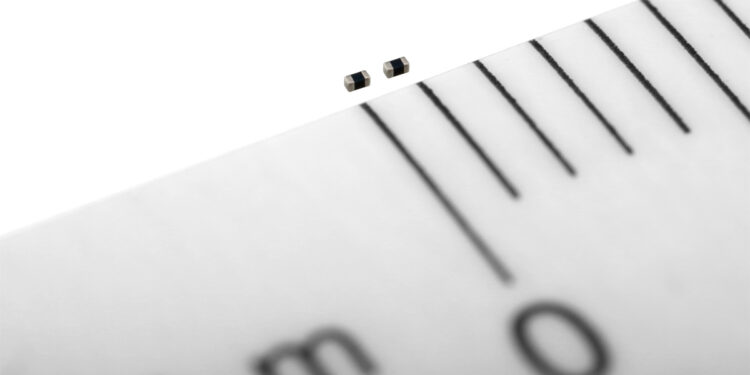TDK Corporation announces the release of its newly developed SMD chip 0402 AVRF041A150MT242 and 0603 AVRF061D2R4ST532 notch filters with ESD protection function. Volume production of these devices will begin in March 2022.
The new notch filters are compliant with the IEC61000-4-2 Level 4 immunity standard. They are well suited to ensuring EMC requirements are met in the audio circuits of key applications – including smartphones, wireless earbuds (TWS), and smart speakers. Thanks to TDK’s proprietary materials and advanced structural design, the new products implement industry-leading attenuation characteristics for specific frequency bands. They are highly effective at noise suppression and improved reception sensitivity in wireless communication. Moreover, the products can simultaneously provide countermeasures against both noise and ESD via one single chip, both reducing costs and using less board real estate.
The AVRF041A150MT242 features a small footprint of only 0.4 x 0.2 x 0.2mm and delivers ESD protection and noise suppression in the 2.4 GHz band. It has a maximum insertion loss of just -20dB at 2.4GHz, The AVRF061D2R4ST532, which is supplied in 0.6 x 0.3 x 0.3mm form factor offers ESD protection and noise suppression in the frequency band up to 5.3GHz. At that frequency, it has a -15dB insertion loss.
With accelerating 5G transition and advanced mutual coordination between connected equipment, the era of IoT is now here. In addition to the conventional demands for lower power consumption and increased functionality, electronic equipment is required to have higher quality design and exhibit ongoing operational reliability. By developing notch filter solutions with significantly smaller footprints and expanded frequency capabilities, TDK is able to address market expectations for more streamlined telecommunication devices, such as smartphones and TWS, while also expanding the frequency band in relation to the latest generation of Wi-Fi transmissions.
Moving forward, TDK will continue to expand its product lineup to meet the needs for diversified telecom applications.
Glossary
- EMC: Electromagnetic compatibility
- ESD: Electrostatic discharge
- TDMA noise: Unpleasant audible noise generated by speakers when high frequency communication signals intrude into a microphone line
- IEC61000-4-2: An immunity standard for electrostatic discharge established by ( the International Electrotechnical Commission (IEC)
Main applications
- Protection against noise and ESD for audio equipment using Wi-Fi, Bluetooth and other wireless forms of communication in the frequency band between 1.0GHz and 5.3GHz
Main features and benefits
- Providing measures for both ESD protection and noise
- Compliant with IEC61000-4-2 Level 4
- The smallest footprint in the lineup (0402 size format)

































